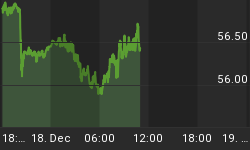What Drives Bond Yields And The Fed?

Since the Fed is the largest player in the bond market, it plays a big role in the direction of interest rates. However in the end, interest rates are determined by all bond market participants. If consumer prices are stable, conservative bonds are more attractive. Conversely, if prices are rising at 4% annually, a 2% bond yield starts to look less attractive. Therefore, investor expectations about future prices could be the most important variable for stocks and bonds in 2015. From Bloomberg:
"Over time, what drives the bond yield is the inflationary expectations," said Lacy Hunt, the 72-year-old chief economist at Hoisington Investment Management. "If you wring all the inflationary expectations out, you are going down to 2 percent on the long bond over the next several years. That is the path that we are on." Based on bond yields, inflation expectations over the next 30 years have fallen below 2 percent and reached a three-year low of 1.96 percent at the end of last month.
If inflation expectations remain relatively stable and low, the Federal Reserve can be more patient when it comes to raising interest rates. All things being equal, low rates are better for stock investors.
What Is The Market Telling Us Now?
The stock market has been hesitant in recent weeks. This week's stock market video compares the present day market with the 2010 flash crash correction in order to better understand the stock market's risk-reward profile.
Video: Stocks - What Do The Facts Say Now?
Shorter-Term Inflation Expectations
The 30-year Treasury yield tells us longer-term inflation expectations remain very tame. How do things look on a shorter-term time horizon? From Reuters:
Falling oil prices and a stronger U.S. dollar did not dampen Americans' inflation expectations last month, according to a Federal Reserve Bank of New York survey... Median expectations of inflation one and three years into the future have remained steady at 3.0 percent since August, even while one-year-ahead gasoline price predictions fell for a fourth straight month, according to the New York Fed's relatively new survey of consumer expectations... A global drop in energy prices and a stronger dollar has put pressure on overall U.S. inflation, which remains below the central bank's 2 percent target. Fed policymakers are not expected to raise interest rates from near zero until about the middle of next year.
Investment Implications - The Weight Of The Evidence
Even in the context of intraday weakness in stocks during Monday's trading session, the intermediate-term outlook remains favorable from a risk/reward perspective. Therefore, we continue to hold an equity-heavy allocation (SPY), with a small complementary stake in bonds (TLT). With a report on producer prices coming this Friday, we will get some additional data to help shape inflation expectations.
Fed Calls For Investor Flexibility
With the Fed considering a shift in policy, it is important that we remain flexible and open to a shift in investors' appetite for risk. If the S&P 500 finishes the week below 2049, our market model may call for an incremental reduction in risk. During Monday's session the S&P 500 was trading at 2,054.
















